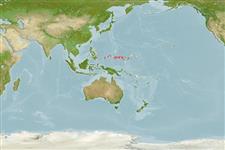>
Ovalentaria/misc (Various families in series Ovalentaria) >
Pomacentridae (Damselfishes) > Chrominae
Etymology: Chromis: Greek, chromis = a fish, perhaps a perch (Ref. 45335); degruyi: Named for Michael V. DeGruy..
Environment: milieu / climate zone / depth range / distribution range
Écologie
marin récifal; profondeur 81 - 120 m (Ref. 59379). Tropical
Western Pacific: Palau.
Taille / Poids / Âge
Maturity: Lm ? range ? - ? cm
Max length : 8.2 cm SL mâle / non sexé; (Ref. 59379)
Épines dorsales (Total): 13 - 14; Rayons mous dorsaux (Total): 11-12; Épines anales 2; Rayons mous anaux: 11 - 12. This species is distinguished by the following: Dorsal rays XIII-XIV, 11-12, usually XIV, 12; anal rays II, 11-12, usually 12; pectoral rays 18; spiniform caudal rays 3; tubed lateral-line scales 15-17; gill rakers 7 + 20-21 (total 27-28); body depth 1.84-1.99 in SL. Color of the adults when fresh is dull brownish yellow with nine thin lavender-gray stripes on the side of body; a prominent black spot on dorsal half of pectoral-fin base (Ref. 59379).
Adults inhabit deep outer-reef slopes at depths of 85-120 m, usually in the vicinity of rock outcrops with small holes and caves, and around limestone talus; usually found in small groups and observed feeding low in the water column (Ref. 59379). Oviparous, distinct pairing during breeding (Ref. 205). Eggs are demersal and adhere to the substrate (Ref. 205). Males guard and aerate the eggs (Ref. 205). Minimum depth reported taken from Ref. 128797.
Life cycle and mating behavior
Maturité | Reproduction | Frai | Œufs | Fécondité | Larves
Oviparous, distinct pairing during breeding (Ref. 205). Eggs are demersal and adhere to the substrate (Ref. 205). Males guard and aerate the eggs (Ref. 205).
Pyle, R., J.L. Earle and B.D. Greene, 2008. Five new species of the damselfish genus Chromis (Perciformes: Labroidei: Pomacentridae) from deep coral reefs in the tropical western Pacific. Zootaxa 1671:3-31. (Ref. 59379)
Statut dans la liste rouge de l'IUCN (Ref. 130435)
Menace pour l'homme
Harmless
Utilisations par l'homme
Plus d'informations
PaysZones FAOÉcosystèmesOccurrencesIntroductionsStocksÉcologieRégime alimentaireÉléments du régime alimentaireConsommation alimentaireRation
Taille/ÂgeCroissanceLongueur-poidsLongueur-longueurFréquences de longueursMorphométrieMorphologieLarvesDynamique des populations larvairesRecrutementAbondanceBRUVS
RéférencesAquacultureProfil d'aquacultureSouchesGénétiqueElectrophoresesHéritabilitéPathologiesTraitementNutrientsMass conversion
CollaborateursImagesStamps, Coins Misc.SonsCiguateraVitesseType de nageSurface branchialeOtolithesCerveauxVision
Outils
Articles particuliers
Télécharger en XML
Sources Internet
Estimates based on models
Preferred temperature (Ref.
123201): 12.8 - 27.4, mean 25.2 °C (based on 5 cells).
Phylogenetic diversity index (Ref.
82804): PD
50 = 0.5000 [Uniqueness, from 0.5 = low to 2.0 = high].
Bayesian length-weight: a=0.01778 (0.00796 - 0.03971), b=2.99 (2.81 - 3.17), in cm total length, based on LWR estimates for this Genus-body shape (Ref.
93245).
Niveau trophique (Ref.
69278): 3.0 ±0.1 se; based on size and trophs of closest relatives
Résilience (Ref.
120179): Haut, temps minimum de doublement de population inférieur à 15 mois (Preliminary K or Fecundity.).
Fishing Vulnerability (Ref.
59153): Low vulnerability (10 of 100).
